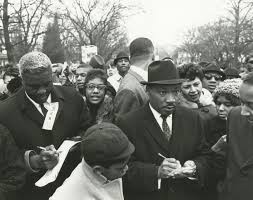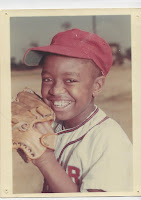Before
getting further into 2018, I need to briefly mention the Negro League players
who took the field for the last inning of life’s game in 2017. The lives on each one I name in this post
were a chapter in the Negro League baseball story. I may not have known about the death this
year of others from the era, so the list could be incomplete.
I
need to mention three players who died in 2017 not involved in the Negro League
baseball era, but were a part of the game’s “Golden Age” (1950s and 1960s). They will be in my next post.
Art
Pennington - January 4, 2017
 |
| Art Pennington |
The
legendary story surrounding Art Pennington has him briefly lifting the
front or back end of an automobile when 10 years old while helping fix a flat
tire. From this event, whether true or
false, his got childhood nickname “superman” which remained with him during his
baseball career. The left-handed 1b/OF played with the Chicago American Giants
from 1940 – 1946, and 1950. A 2-time
Negro League All-Star (1942, 1950), Pennington also played in the Mexican
League during the late 1940s. One of a
group of African American players that integrated professional baseball’s minor
league system in the early 1950s, Pennington finally signed with the New York
Yankees in 1958. At 35 years old, he
briefly played in the team’s lower minor league before retiring after the 1959
season.
Paul
Casanova - January 12, 2017
 |
| Paul Casanova |
An
excellent defensive catcher from Cuba with a strong throwing arm, Casanova
first signed with the Cleveland Indians in 1960. After being released, he finished the 1961
season with the Indianapolis Clowns, the final remnant of Negro League
baseball. While Casanova played with a
semi-pro team in 1963, a scout for the Washington Senators noticed him. He remembered seeing Casanova play with the Clowns
and signed him. Casanova went on to have
a 10 year Major League career, 7 with the Senators (1965 – 1971). In 1967, he played in 141 games and was named to the American League All-Star team.
Cleophus
Brown -
March 14, 2017
 |
| Cleophus Brown |
The
left-handed pitcher and first baseman played in the Negro Leagues during the
decade the era limped to its eventual end.
A Korean War vet, Brown signed on with the Louisville Clippers in 1955
an independent team. It had been in the
Negro American League (NAL), but dropped out after the 1954 season. After one season with Louisville, Brown
worked in the Birmingham, AL. steel mills (17 years) and then the Post Office
while playing in the city’s semi-professional baseball Industrial Leagues.
John
L. Gray - May 4, 2017
 |
| John L. Gray |
Gray
attended Central State College in Wilberforce, Ohio and then signed with the
Cleveland Indians in 1956 as a catcher and outfielder. He played that first year with the Indians’
Class D minor league affiliate the Daytona Beach Islanders (Florida State League). In 1958 after some dissatisfaction with the
Indian’s minor league system, Gray signed with the Indianapolis Clowns of the
Negro American League (NAL). While with
the Clowns, Gray hit a home run at Yankee Stadium which he frequently mentioned
to his children and grandchildren in his golden years. He finished his baseball career playing in
the minor league system of first the
Chicago Cubs in 1959 and then the Chicago White Sox in 1960.
Maurice
Peatross - June 26, 2017
 |
| Maurice Peatross |
In
1944, while 17 years old, Peatross played for the Pittsburgh Crawfords in the
short lived United States Negro Baseball League. The 6’1”, 230 pound first baseman went into
the military after high school and returned in 1947 to sign with the Homestead
Grays as backup support for the aging Buck Leonard. The legendary first
baseman was 40 years old and still the main drawing card for the Grays. Signed by the Brooklyn Dodgers in 1949, Peatross
spent the next four years in the team’s minor league system and then retired
from baseball
to spend more time with his growing family.
Bob
Motley -
September 14, 2017
 |
| Bob Motley |
The
last surviving and one of the most well-known umpires in Negro League baseball,
Motley entertained fans during the late 1940s and the 1950s with his animated
calls. The ex-marine World War II Purple
Heart recipient handled the umpiring duties for the games of such Negro League
players who went on to the Major Leagues such as Satchel Paige, Willie Mays,
Ernie Banks, Henry Aaron, and Elston Howard.
Motley tenaciously fought to overcome the racial discrimination he faced
as a professional umpire. He became the
second African American umpire in the Pacific Coast League (PCL) in 1959.
Willie
James Lee and Archie “Dropo” Young
 |
| Willie Lee James |
 |
| Archie "Dropo" Young |
The former teammates on the Birmingham Black Barons died within the same week in 2017. Willie James Lee died on October 12 and Archie “Dropo” Young died October 19. They were briefly teammates with the Black Barons in 1956. After one game Lee went on to the Kansas City Monarchs where he got the reputation of being a power hitting outfielder. Constant injuries hampered his development in the minor league systems of first the Detroit Tigers and then the Minnesota Twins from 1959 – 1964. A Korean War veteran, Archie Young played with the Black Barons in 1956 and 1957 while also working in job in the coal mines. The power hitting first baseman got the nickname “Dropo” after the American League first baseman during that time, Walt Dropo.
Mamie
“Peanut” Johnson - December 19, 2017
 |
| Mamie "Peanut" Johnson |
One
of three women (also Connie Morgan and Toni Stone) who played Negro League
baseball in the 1950s, Mamie Johnson pitched for the Indianapolis Clowns from
1953 – 1955. Johnson stood 5’3” and
weighed 120 pounds. An opposing player said she “looked like a peanut” on the
mound and that started the nickname “Peanut”.
With Negro League baseball on a steady decline during the 1950s, the
Clowns added comedy routines to their performance on the field in hopes of
attracting fans to the games. But
Johnson’s pitching had nothing to do with comedy. A regular in the Clown’s rotation, she had an
arsenal of pitches to throw against opposing batters; slider, curve ball,
screwball, change of pace, and a fastball that got to home plate sooner than hitters
expected. Her unofficial 3-year record
is given as 33 – 8. Racial
discrimination banned her from playing in the All-American Girls Professional
League (AAGPL) as in the movie “A League of Their Own”. After baseball, Johnson had a long successful
nursing career.









